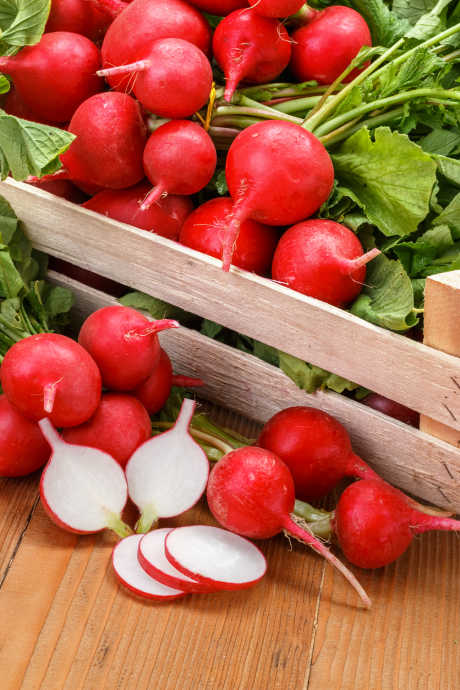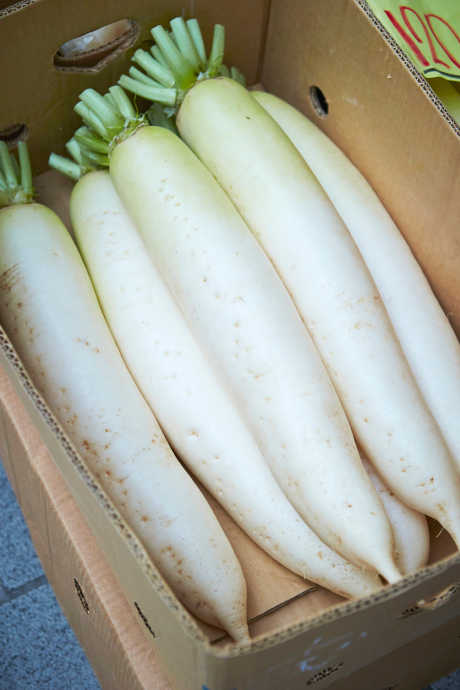Get a Rosy Outlook on Radish Recipes
Posted by Julie on Jun 20th 2019
Radishes aren’t usually high on people’s list of favorite vegetables. They’re typically used in green salads to add a pop of color, or carved and soaked in water to resemble roses. That may be the only way you’ve eaten them. If you’ve never tried other varieties of radishes beyond the familiar round red ones, we hope you’ll give them another chance or two. Keep reading to learn more about how to prepare this root vegetable, along with four recipes -- one for each of the most well-known radish varieties.
The Basics of Radishes
Radishes are part of the mustard family, which also includes arugula and cabbage. (Cabbage runs the gamut from broccoli and cauliflower to Brussels sprouts and turnips.) They’ve become increasingly popular with low-carb diets, but they’re worth adding to anyone’s food repertoire. They’re packed with vitamins and minerals, and they’re high in fiber too. The flavor and texture vary depending on radish type and freshness, but they’re generally crisp with a spicy bite.

Look for radishes with smooth skin, with no cracks or blemishes. Firm radishes on the smaller side will be crisper and milder in flavor. Steer clear of larger radishes that give when you squeeze them. Not only will their texture be less appealing, they will also have a more pungent flavor.
How to Prepare Radishes
Radishes will keep in the refrigerator for a few days. Remove the greens from radishes before storing; they will dry out the radish bulb if you leave them attached. Otherwise, don’t wash or slice radishes until you are ready to use them. If you’re going to serve them raw, fill a bowl or pot with ice water, and soak the radishes in it for a few hours ahead of time. It will help add to their crisp texture.
While radishes are most often sliced thinly or cut into julienne strips for green salads, they are more versatile than you might expect. Try pickling them just as you would with cucumbers or carrots. Just like those other vegetables, pickled radishes have an appealing crunch.
You can also cook radishes in the same way you’d cook other root vegetables, like potatoes. Try braising or roasting them. They’re even great for grilling. Add them to stew or soup in the winter, or thread them onto skewers with other vegetables of similar hardness for summer grilling.
Types of Radishes
Round red radishes are the ones you’ll find in green salads. You may also see color variations ranging from pink to purple. Slice them or julienne them for eating raw, and quarter them or halve them for cooking. This variety is a good candidate for roasting or braising.
French radishes are similar to the round red variety, except they have a more oval or cylindrical shape. Because their flavor isn’t as pungent as round radishes, they’re usually eaten raw in the French style. We’ll share the details below.

Daikon radishes are large and rectangular in shape, and their flesh is white. Look for Daikon radishes with greens, as they have a milder flavor. You can pickle, braise, or roast this variety. There are also lots of recipes for Daikon radish “French fries.” While they won’t taste like a French fried potato, it’s another option to keep in mind.
Finally, watermelon radishes are a beautiful addition to salads, or they can be the main ingredient in a salad. As their name implies, this variety has a green exterior and bright pink flesh inside. Slice them, julienne them, or cut them into wedges like an actual watermelon and serve with dipping sauce.
4 Radish Recipes to Try
If you want to eat radishes like the French, refer to these tips from Dorie Greenspan. Wash your elongated French radishes, and remove the greens and stems. Then carefully slice each radish in half, leaving the base attached. Spread a dab of butter between both halves of the radish, dip it in salt, and pop it into your mouth. Why butter? Greenspan explains how the French use butter to mellow strong flavors, like the peppery taste of radishes. Give it a try; you may discover you love radishes eaten this way.
You can also eat round radishes in the French style, but we’re curious to try this recipe from Running to the Kitchen in which Gina roasts them instead. Wash, trim, and halve or quarter your radishes. Then toss them with olive oil, salt, pepper, honey, and fresh rosemary before roasting them in the oven. To make these radishes extra special, whip up some dipping sauce with Greek yogurt, Dijon mustard, honey mustard, and lemon juice.
This recipe from Food 52 makes an Asian-inspired salad with carrots and Daikon radishes. It would make a delicious complement to an Asian feast, or a refreshing summer side dish. Grate or julienne the carrots and radishes. Then grate fresh ginger and mince fresh garlic, and add to the vegetables. Whisk together oil, rice vinegar, and sriracha. While the recipe calls for canola oil, we would try sesame oil instead. Finally, sprinkle toasted sesame seeds over the top.

Finally, we think this salad from Alexandra Cooks is gorgeous, thanks to watermelon radishes. It even calls for ingredients that will be in season over the winter, so serve it to brighten up a dreary day. Peel the watermelon radishes so a thin layer of green skin remains. Then use a mandoline to carefully make paper-thin slices. Pile the radish slices on a serving platter, and squeeze citrus juice over them. Cara cara oranges or clementines are both tasty. Add the citrus segments to the watermelon radish slices, and top with goat cheese and walnuts. Finally, whisk together minced shallots, white balsamic vinegar, and salt for the dressing to drizzle over the top.

